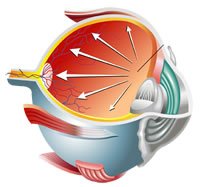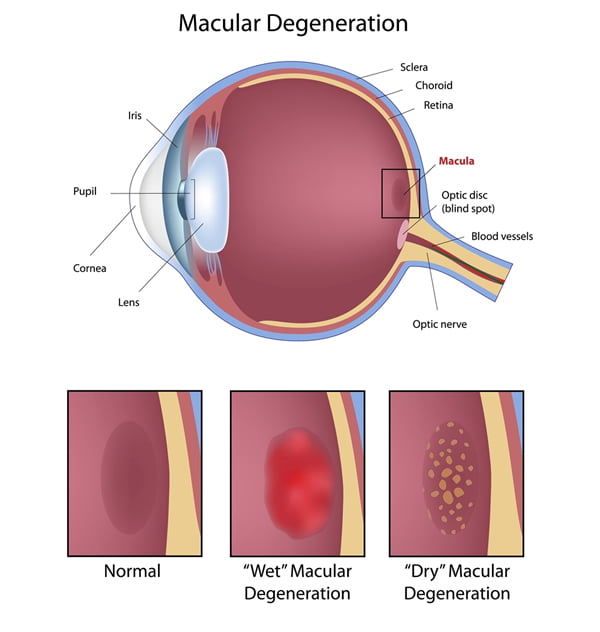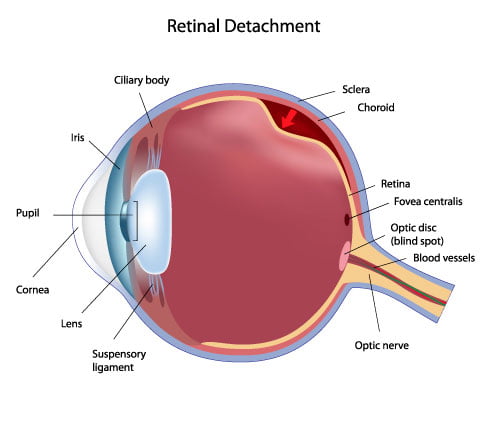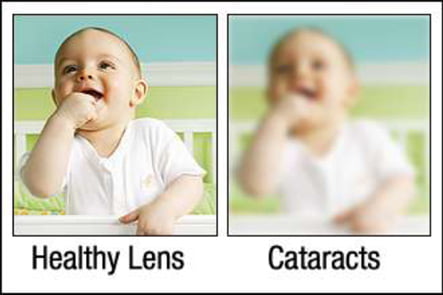Astigmatism
Astigmatism is a condition that causes blurred vision. It is caused by an irregular shaped cornea. (However, sometimes it is caused by curvature of the lens inside the eye.) An irregular shaped cornea or lens stops light from properly focusing on the retina (the light sensitive area at the back of the eye) and that causes vision to be blurred at any distance. Astigmatism is very common and it is often associated with blurred vision, eye discomfort and headaches. Diagnosis and treatment options are available through an eye exam with Dr. Stoelting.

Cataract
Cataract: When the lens inside the eye becomes clouded, it leads to a decrease in vision. We call this condition a cataract. Visual loss occurs because of opacification of the lens. It obstructs light from being focused on the retina.
People with cataracts frequently experience difficulty in seeing colors vividly and they cannot see changes in contrast as well. Driving, reading, recognizing faces, and dealing with glare from bright lights are often challenging. While cataracts are a leading cause of blindness, cataracts can be treated with surgery. There are many exciting developments in treating cataracts like laser cataract surgery. Dr. Stoelting provides careful cataract evaluation and post-operative care. Call his office to make an appointment.
Diabetic Retinopathy
Diabetic retinopathy is a complication of diabetes and a leading cause of blindness. It occurs when diabetes damages the tiny blood vessels inside the retina, the light-sensitive tissue at the back of the eye. A healthy retina is necessary for good vision. If you have diabetic retinopathy, at first you may not notice a change in your vision. But over time, diabetic retinopathy can get worse and cause vision loss. Diabetic retinopathy usually affects both eyes.
Diabetic retinopathy has four stages:
- Mild Nonproliferative Retinopathy. At this earliest stage, microaneurysms occur. They are small areas of balloon-like swelling in the retina’s tiny blood vessels.
- Moderate Nonproliferative Retinopathy. As the disease progresses, some blood vessels that nourish the retina are blocked.
- Severe Nonproliferative Retinopathy. Many more blood vessels are blocked, depriving several areas of the retina from sending signals to the body to grow new blood vessels for nourishment.
- Proliferative Retinopathy. At this advanced stage, the signals sent by the retina for nourishment trigger the growth of new blood vessels. This condition is called proliferative retinopathy. These new blood vessels are abnormal and fragile. They grow along the retina and along the surface of the clear, vitreous gel that fills the inside of the eye.
By themselves, these blood vessels do not cause symptoms or vision loss. However, they have thin, fragile walls. If they leak blood, severe vision loss and even blindness can result. Remember: If you have diabetes, get a comprehensive dilated eye exam at least once a year. With diabetes, your eyes need special attention. Proliferative retinopathy can develop without symptoms. At this advanced stage, you are at high risk for vision loss. Macular edema can develop without symptoms at any of the four stages of diabetic retinopathy. You can develop both proliferative retinopathy and macular edema and still see fine. However, you are at high risk for vision loss. Whether or not you have symptoms, early detection and timely treatment can prevent vision loss. Diagnosis and treatment options are available through an eye exam with Dr. Stoelting.
Glaucoma

Glaucoma is the second most common cause of blindness in the United States. It is a very sneaky eye disorder. Since there are no signs and symptoms, glaucoma is like a “silent thief”. Regular eye exams can ensure early diagnosis allowing for more treatment options. (So, never miss your eye exams, especially if you are diabetic or if glaucoma runs in your family.) Glaucoma is a disorder that causes progressive damage to the optic nerve thereby causing vision loss. (The optic nerve is a bundle of about one million individual nerve fibers which transmits visual signals from the eye to the brain.) The most common type of glaucoma is called primary open-angle glaucoma. It is usually associated with an increase in the fluid pressure inside the eye. If left untreated, glaucoma can lead to significant loss of vision or even blindness. Diagnosis and treatment options are available through an eye exam with Dr. Stoelting.
Hyperopia (Farsightedness)

Hyperopia, or more commonly known as farsightedness, is a vision condition in which distant objects can be seen clearly, but close objects are not. Farsightedness develops if your eyeball is too short or if the cornea does not have enough curvature. As a result, the light that enters your eye is not focused correctly.
Typical signs of farsightedness include: eye strain, difficulty maintaining a clear focus on objects close by, fatigue and/or headaches after close work, aching or burning eyes, and even irritability or nervousness after sustained concentration. Diagnosis and treatment options are available through an eye exam with Dr. Stoelting.
Macular Degeneration
Macular Degeneration is an eye disease that affects the macula, the center of the light sensitive retina at the back of the eye. As a result, it causes the loss of central vision. It is the leading cause of severe vision loss in adult age 50 and over. The Centers for Disease Control and Prevention estimate that 1.8 million people have macular degeneration and that another 7.3 million people are at substantial risk to develop it.

In its early stages, signs of macular degeneration are often unnoticed unless you have an eye exam. When you visit Dr. Stoelting, he will perform a variety of tests to determine if you have macular degeneration, or any other eye health problems. Symptoms of macular degeneration include: the gradual loss of vision to objects clearly, objects may appear distorted in shape, a loss of clear color vision, and a dark or empty area appears in the center of vision. There are two types of macular degeneration and they are “dry” macular degeneration and the less common “wet” macular degeneration. With “dry” macular degeneration, the macula slowly becomes thin and stops functioning well. There is no cure for this type of macular degeneration and the loss in central vision cannot be restored. (However, there is hope. Early detection can help so call Dr. Stoelting for appointment to learn more.) The less common “wet” macular degeneration prompts rapid and severe vision loss. It occurs when fluids leak from newly formed blood vessels under the macula and blur central vision. If detected early, “wet” macular degeneration can be treated with laser treatment. Diagnosis and treatment options are available through an eye exam with Dr. Stoelting.
Macular Edema
Macular edema develops when fluid and protein deposits collect on the macula causing it to thicken and swell. Due to the fact that the macula is near the center of the retina, the swelling (edema) usually alters a person’s central vision. Macular edema often occurs alongside of diabetic retinopathy. It can occur at any stage of diabetic retinopathy, although it is more likely to occur as the disease progresses. (About half of the people with proliferative retinopathy also have macular edema.) There are numerous treatment options for macular edema, especially if it is treated early. Diagnosis and treatment options are available through an eye exam with Dr. Stoelting.
Myopia (Nearsightedness)
Myopia, also known as nearsightedness, is a condition when close objects are seen clearly, but faraway objects are out of focus. Nearsightedness occurs when the eyeball is too long or if the cornea has too much curvature; that causes light entering the eye to be improperly focused. Therefore, distant objects appear blurred. Nearsightedness is a very common vision condition. In fact, it affects approximately 30 percent of Americans. It typically first occurs in school-age children. However, it is possible for adults to develop nearsightedness due to visual stress or health issues like diabetes.

Common signs of nearsightedness include difficulty seeing distant objects clearly such as a movie or TV screen or a whiteboard in school. Diagnosis and treatment options are available through an eye exam with Dr. Stoelting.
Presbyopia
Presbyopia is a vision condition that makes it difficult for you to focus on close objects. It happens when your eye’s crystalline lens loses its flexibility. Presbyopia may seem to happen quickly, but it actually takes place over a period of years. It commonly becomes noticeable when people are in their 40s. Presbyopia is a natural part of the eye’s aging process. It is neither a disease nor can it be prevented.

Signs of presbyopia include the holding reading materials at arm’s length, blurred vision at normal reading distance, eye fatigue, and headaches from doing close work. To learn more or to receive help in addressing presbyopia, schedule an appointment with Dr. Stoelting.
Retinal Detachment
A retinal detachment is a serious disorder of the eye when the retina peels away from its underlying layer of support tissue. Light focuses on the retina in a similar way that light focuses on a sensor in a camera. The retina translates the focused image into neural impulses and it transmits them to the brain through the optic nerve.

Causes of a retinal detachment include injury or trauma to the eye or head. The tear allows vitreous fluid to seep through it under the retina. As a result, it peels it away like a bubble in wallpaper. Without rapid treatment, the entire retina may detach, leading to vision loss and blindness. It is a medical emergency and permanent eye damage may occur if the detachment is not repaired within 24–72 hours. *Dr. Stoelting is very capable and experienced in retinal detachment diagnosis. If Dr. Stoelting determines that you have a retinal detachment, you will be referred to a specially trained retina specialist for prompt treatment. Dr. Stoelting is very skilled in coordinating emergency care for retinal detachments.


